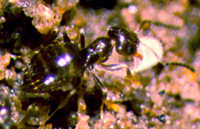About 300 species of ants (Hymenoptera: Formicidae) occur in Texas. Most are not pests. However, several species like imported fire ants bite and sting and others can become a nuisance when they occur in and around the home in high numbers. Ants are social insects and their colonies often consist of one or more queen ants, developmental stages (larvae and pupae) and sterile female worker ants that serve to maintain the colony and forage for food. Food sources vary by species but many are omnivorous, meaning they eat a variety of substances suiting their energy and developmental needs.
Identification: How do I spot them?
Rover worker ants are small (about 1/16″), uniform in size (they are monomorphic), and vary in color from black, dark brown to pale blonde. They have 9-segmented antennae without a club, a 1-segmented petiole which is hidden under the abdomen and they do not possess a stinger. The thorax is uneven in shape and the front portion is humped (see figure below).
Impact: What effects do they have?
In the past, rover ants were rarely considered as a pest ant. In recent years though, this ant has become more and more prevalent throughout the state. Pest Management Professionals are reporting increased incidents of rover ants inside of structures. These ants are of little economic and medical importance because they do not bite or sting. However, they can be a nuisance in areas where ants are not tolerable, particularly indoors.
Biology: ID Characteristics & Behavior
Colonies are small ranging in from hundreds to a few thousands members. They contain only one queen per colony. Colonies are usually found in the soil or rotting wood but they will nest in potted plants, wall voids and other harborages. Colonies are commonly associated with soil dwelling aphids and mealy bugs that produce honey dew, a sugary liquid extracted from plants on which these sucking insects feed.
Colonies are formed by mating flights of winged male and female individuals. These flights usually occur in the evening during summer months and winged sexual (alates) are attracted to lights.
Distribution: Where are they found?
Two species are positively identified in Texas, B. depilis and B. obscurior. It is widespread throughout the state and B. obscurior is known to be in the southern portion of the state. It is thought that there may be a third species that has recently been brought to Texas. The population and distribution of Brachymyrmex ants in Texas is expanding.
Management: What can you do for them?
Non-chemical or cultural controls should be considered for controlling these ants first. Infestations are often associated with moisture and or fungal decay. Correction of moisture problem will help with control. Any wood that is severely damaged due to water should be replaced. Around the home, remove or treat nesting areas under landscape timbers or rocks.
Rover ants have proven to be one of the more difficult ants to control. They seem to be not attracted to many liquid or granular ant bait formulations. Find entry points on exterior of structure and seal if possible and/or treat with a contact insecticide. Gel baits and dusts may be used in electrical sockets for indoor control. If ants are in a void area, an aerosol may be used. Always follow all pesticide label directions.
References
Dash, S.T., L.M. Hooper-Bui, and M.A. Seymour. 2005. The Pest Ants of Louisiana: A Guide to Their Identification, Biology and Control. Louisiana Cooperative Extension Service Publication 2915-5M.
Ferster, B. M. Deyrup, and R. H. Scheffrahn. 2000. The Pest Ants of Florida. Fort Lauderdale R.E.C. Research Report FTL 00-1.
Hedges, Stoy A., Pest Control Technology Field Guide for the Management of Structure Infesting Ants. 1998. G.I.E. Inc. Publishers. Cleveland, OH.
Klotz, J., L. Hansen, R. Pospischil, and M. Rust.2008. Urban Ants of North America and Europe Identification, Biology, and Management. Cornell University Press. Ithaca, NY.
O’Keefe, S.T., J.L. Cook, T. Dudek, D.F. Wunneburger, M.D. Guzman, R.N. Coulson, and S. B. Vinson. 2000. The Distribution of Texas Ants. Southwestern Entomologist 22(supplement):1-92.
Vinson, S.B., S.T. O’Keefe, and J.L. Cook. The Common Ant Genera of Texas ID Guide. 2003. Texas A&M Extension Publication B-6138.
————–
Prepared by Chris Keefer, June 2010.
